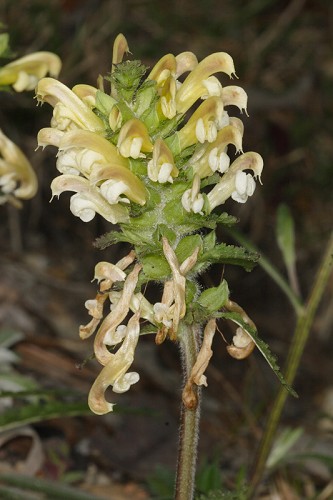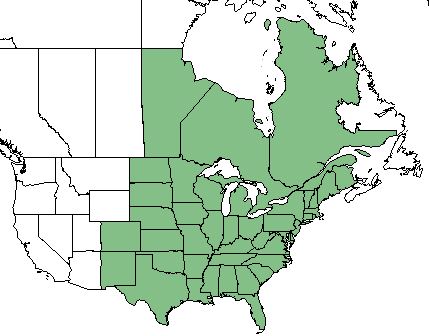Difference between revisions of "Pedicularis canadensis"
| Line 34: | Line 34: | ||
''P. canadensis'' proliferates in moist to dry forests and woodlands and streambanks. <ref name= "Weakley 2015"> Weakley, A. S. (2015). Flora of the Southern and Mid-Atlantic States. Chapel Hill, NC, University of North Carolina Herbarium. </ref> | ''P. canadensis'' proliferates in moist to dry forests and woodlands and streambanks. <ref name= "Weakley 2015"> Weakley, A. S. (2015). Flora of the Southern and Mid-Atlantic States. Chapel Hill, NC, University of North Carolina Herbarium. </ref> | ||
===Phenology=== <!--Timing off flowering, fruiting, seed dispersal, and environmental triggers. Cite PanFlora website if appropriate: http://www.gilnelson.com/PanFlora/ --> | ===Phenology=== <!--Timing off flowering, fruiting, seed dispersal, and environmental triggers. Cite PanFlora website if appropriate: http://www.gilnelson.com/PanFlora/ --> | ||
| − | ''P. canadensis'' flowers March-May. <ref name= "PanFlora"> PanFlora Author: Gil Nelson URL: [http://www.gilnelson.com/PanFlora/ http://www.gilnelson.com/PanFlora/] Date Accessed: 5/24/18 </ref> | + | ''P. canadensis'' flowers March-May. <ref name= "PanFlora"> PanFlora Author: Gil Nelson URL: [http://www.gilnelson.com/PanFlora/ http://www.gilnelson.com/PanFlora/] Date Accessed: 5/24/18 </ref> STEMS: unbranched, up to 20 cm tall. LEAVES: deeply dissected, 10 cm long, 4 cm wide, most of the leaves clustered at the base of the stem. FLOWERS: borne in dense heads, two-lipped, 2 cm long, 0.5 cm wide. CAPSULE: 1 cm long, enclosed by green sepals. SEEDS: about 10 per capsule 5 mm long, brown. <ref name= "Musselman and Mann 1978"> Musselman, L. J. and W. F. Mann, Jr (1978). Root parasites of southern forests. , USDA Forest Service, Southern For. Exp. Station, New Orleans, LA. Gen. Tech. Rpt. SO-20. : 76. </ref> |
<!--===Seed dispersal===--> | <!--===Seed dispersal===--> | ||
<!--===Seed bank and germination===--> | <!--===Seed bank and germination===--> | ||
| + | |||
===Fire ecology=== <!--Fire tolerance, fire dependence, adaptive fire responses--> | ===Fire ecology=== <!--Fire tolerance, fire dependence, adaptive fire responses--> | ||
''P. canadensis'' is not fire resistant, but has a medium fire tolerance. <ref name= "USDA Plant Database"/> | ''P. canadensis'' is not fire resistant, but has a medium fire tolerance. <ref name= "USDA Plant Database"/> | ||
Revision as of 15:15, 18 June 2018
Common name: Canadian lousewort [1], eastern lousewort [2], wood-betony [2]
| Pedicularis canadensis | |
|---|---|

| |
| Photo by John Gwaltney hosted at Southeastern Flora.com | |
| Scientific classification | |
| Kingdom: | Plantae |
| Division: | Magnoliophyta - Flowering plants |
| Class: | Magnoliopsida - Dicots |
| Order: | Scrophulariales |
| Family: | Scrophulariaceae |
| Genus: | Pedicularis |
| Species: | P. canadensis |
| Binomial name | |
| Pedicularis canadensis L. | |

| |
| Natural range of Pedicularis canadensis from USDA NRCS Plants Database. | |
Contents
Taxonomic Notes
Synonyms: none
Varieties: none
Description
P. canadensis is a perennial forb/herb/subshrub of the Scrophulariaceae family native to North America and Canada. [1]
Distribution
P. canadensis is found in the eastern half of the United States, as well as the Manitoba, Ontario, and Quebec regions of Canada. [1]
Ecology
Habitat
P. canadensis proliferates in moist to dry forests and woodlands and streambanks. [2]
Phenology
P. canadensis flowers March-May. [3] STEMS: unbranched, up to 20 cm tall. LEAVES: deeply dissected, 10 cm long, 4 cm wide, most of the leaves clustered at the base of the stem. FLOWERS: borne in dense heads, two-lipped, 2 cm long, 0.5 cm wide. CAPSULE: 1 cm long, enclosed by green sepals. SEEDS: about 10 per capsule 5 mm long, brown. [4]
Fire ecology
P. canadensis is not fire resistant, but has a medium fire tolerance. [1]
Conservation and Management
Cultivation and restoration
Photo Gallery
References and notes
- ↑ 1.0 1.1 1.2 1.3 USDA Plant Database https://plants.usda.gov/core/profile?symbol=PECA
- ↑ 2.0 2.1 2.2 Weakley, A. S. (2015). Flora of the Southern and Mid-Atlantic States. Chapel Hill, NC, University of North Carolina Herbarium.
- ↑ PanFlora Author: Gil Nelson URL: http://www.gilnelson.com/PanFlora/ Date Accessed: 5/24/18
- ↑ Musselman, L. J. and W. F. Mann, Jr (1978). Root parasites of southern forests. , USDA Forest Service, Southern For. Exp. Station, New Orleans, LA. Gen. Tech. Rpt. SO-20. : 76.